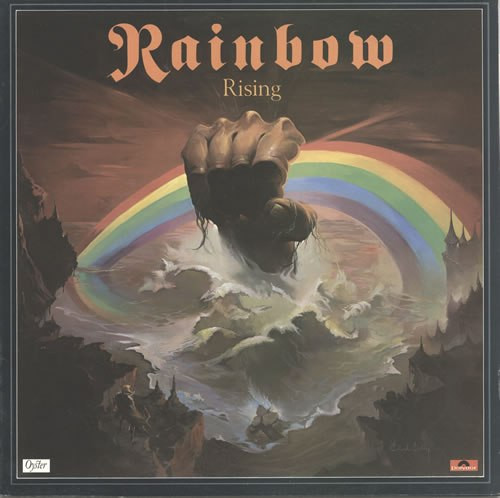„Stargazer“ is the magnum opus of Rainbow’s 1976 album Rising, widely regarded as one of the greatest epic heavy metal songs ever written. Featuring Ronnie James Dio’s commanding vocals, Ritchie Blackmore’s neoclassical guitar mastery, and Cozy Powell’s thunderous drumming, the song crafts a dark, mythical tale of ambition, tyranny, and disillusionment.
A nine-minute epic, „Stargazer“ combines fantasy storytelling with deep philosophical themes, evoking imagery reminiscent of ancient civilizations, oppressive rulers, and doomed dreams. The song is often interpreted as a metaphor for blind faith, the dangers of unchecked ambition, and the crushing weight of human folly.
Overview
At its core, „Stargazer“ explores:
- The rise and fall of an ambitious yet deluded tyrant.
- The suffering of enslaved people who build his grand vision.
- The theme of shattered dreams and lost hope.
- A metaphor for the dangers of blind faith and manipulation.
Narrative Structure & Themes
1. The Enslavement & Labor (Building the Tower of Madness)
- The song opens from the perspective of an enslaved worker, forced to toil under the rule of a powerful sorcerer:
„High noon, oh, I’d sell my soul for water
Nine years worth of breaking my back“
- The opening lines establish a sense of suffering, exhaustion, and desperation.
- The desert setting evokes biblical and mythological imagery, resembling the construction of the Tower of Babel or the pyramids of Egypt.
- The workers are driven to their limits, building a structure to fulfill the mad dreams of their ruler.
- Themes: Oppression, suffering, servitude, religious fanaticism.
2. The Sorcerer’s Grand Ambition (The Tyrant’s Delusion)
- The central figure of the song, the Stargazer, is a powerful sorcerer who believes he can fly to the stars once his massive tower is complete:
„See the man with the magic in his eyes
He’s got the tower, he’s way up high“
- The sorcerer is blinded by his own ego and belief in his supernatural power.
- His obsession with reaching the sky mirrors mythological figures like Icarus, symbolizing the fatal flaw of unchecked ambition.
- He is charismatic yet delusional, leading others into a futile struggle.
- Themes: Tyranny, blind ambition, self-destruction.
3. The Crushing Reality (Failure & Disillusionment)
- As the tower nears completion, the truth becomes clear—the sorcerer’s dream was nothing but a lie:
„All eyes see the figure of the wizard
As he climbs to the top of the world
No sound as he falls instead of rising
Time standing still, then there’s blood on the sand“
- The climax of the song sees the sorcerer ascending his tower, expecting to fly—only to plummet to his death.
- The workers, who sacrificed years of their lives, realize they were deceived.
- The „blood on the sand“ is a powerful image of futility and wasted life.
- Themes: Betrayal, lost hope, the illusion of power.
4. The Survivor’s Reflection (Freedom & Lessons Learned)
- After the sorcerer’s death, the enslaved workers are left to wonder what it was all for:
„Where is your star?
Is it far, is it far, is it far?“
- This refrain is both literal and metaphorical—they question the promise of the stars, the false hope they were given.
- The realization of betrayal is both sorrowful and liberating—they are no longer enslaved, but left in the ruins of a wasted dream.
- The last words suggest a desperate yearning for purpose, even after everything has crumbled.
- Themes: Disillusionment, freedom, existential crisis.
Themes & Symbolism
1. The Dangers of Blind Faith & Manipulation
- The enslaved people followed the sorcerer’s vision without question, much like how people can be manipulated by cult leaders, political figures, or ideologies.
- The song warns against placing trust in false prophets who demand sacrifice for their own delusions.
2. The Hubris of the Powerful
- The sorcerer represents rulers, visionaries, or dictators who push others toward destruction in pursuit of impossible dreams.
- His fall is inevitable, echoing historical figures who overreached and paid the price.
3. The Crushing Weight of Lost Dreams
- The workers spent years believing they were part of something greater, only to see it crumble before their eyes.
- The final refrain is one of sorrow and existential questioning—what happens when the dream dies?
Musical & Emotional Impact
1. Monumental Orchestration & Cinematic Atmosphere
- Ritchie Blackmore’s guitar work is deeply neoclassical, giving the song an orchestral, dramatic feel.
- The slow-building tension mirrors the construction of the tower, culminating in a crushing, tragic climax.
2. Ronnie James Dio’s Powerful Storytelling
- Dio’s vocal delivery is unmatched in its theatricality and emotion, bringing the enslaved worker’s perspective to life.
- His ability to switch from sorrowful, yearning lines to triumphant, commanding vocals enhances the song’s dynamic nature.
3. Cozy Powell’s Thunderous Drumming
- Powell’s tribal, pounding drums create a marching, laborious feel, immersing the listener in the hardship of the workers.
- His explosive fills and sheer power elevate the song to near-orchestral levels.
Legacy & Influence
- „Stargazer“ is widely regarded as one of the greatest heavy metal epics of all time, influencing bands like Iron Maiden, Manowar, and Symphony X.
- Its grand storytelling, dark themes, and larger-than-life musicianship set the blueprint for power metal and progressive metal epics.
- The song’s themes of ambition, oppression, and lost dreams resonate far beyond metal, making it a timeless cautionary tale.
Final Verdict
„Stargazer“ is not just a song—it is a monumental heavy metal odyssey. With a tragic narrative, deep philosophical themes, and legendary musical execution, it remains one of the most powerful and cinematic compositions in rock and metal history.
Its themes of blind ambition, disillusionment, and the price of servitude make it timeless, thought-provoking, and deeply moving. Few songs in metal history have achieved this level of storytelling and emotional weight.
This is Rainbow’s magnum opus and a masterpiece of heavy metal art.



